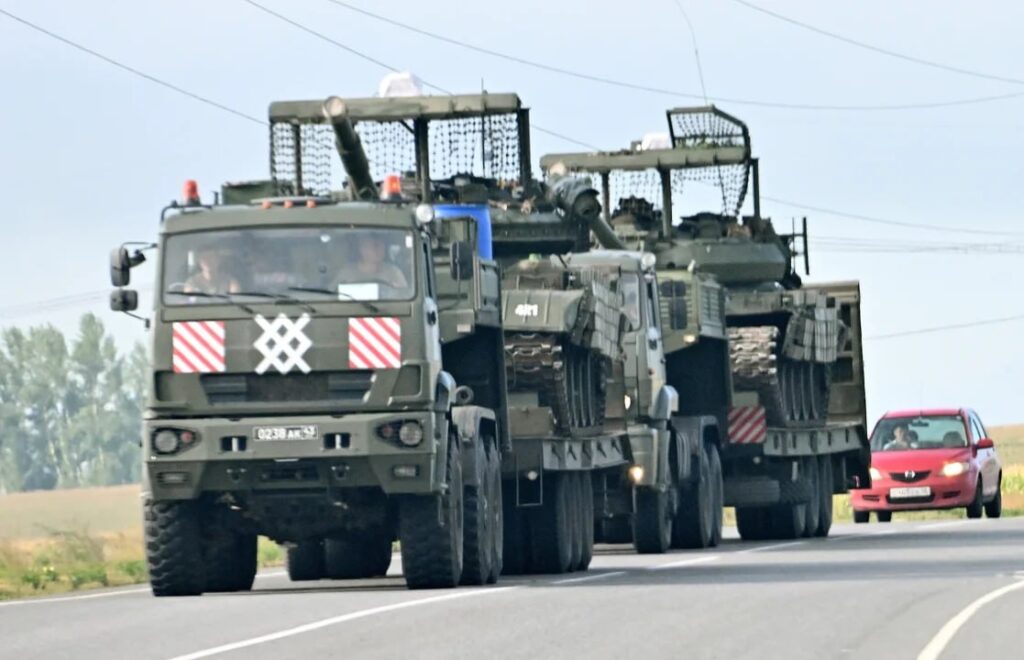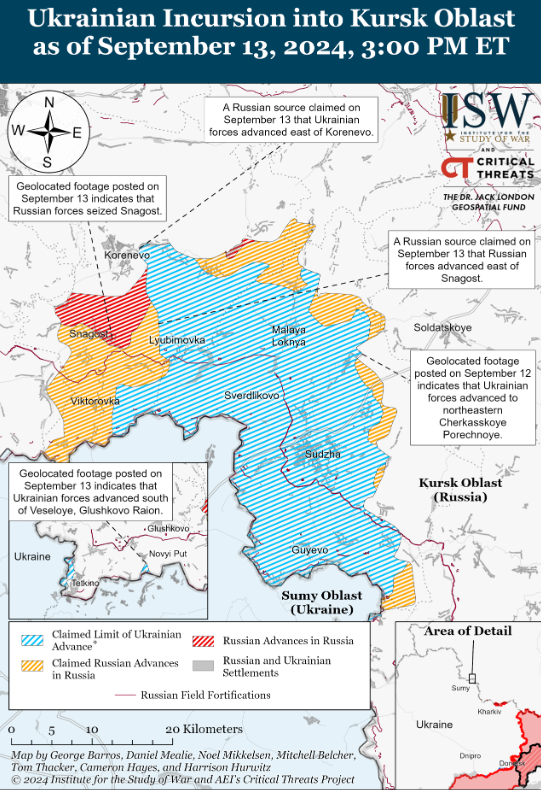Russia’s counteroffensive in Kursk puts Ukraine’s gambit to the test
As Russian forces push into Kursk Oblast, experts debate: Is this the end of Ukraine's bold advance, or exactly what Kyiv planned?


In recent days, the Russian army launched a counteroffensive in Kursk Oblast aiming to expel Ukrainian forces that recently seized about 1,000 square kilometers of Russian territory. This unprecedented Ukrainian advance captured dozens of villages and the district center of Sudzha – the first such incursion in 80 years.
Kyiv’s bold move has tested the Kremlin’s “red lines” – presumed boundaries of acceptable action that, if crossed, would provoke severe retaliation. Surprisingly, this violation of Russia’s territorial integrity has not triggered the dramatic escalation that Western nations have long feared.
Now, as Russia mobilizes its troops for a pushback, a critical moment approaches. The question remains: can Ukrainian forces hold their newly gained positions? Euromaidan Press investigates the unfolding situation in Kursk Oblast.
On the ground in Kursk
Russian forces have launched a counteroffensive along the Korenevo-Snagost line in Kursk Oblast. Capturing Snagost, a key Ukrainian stronghold, could unblock 2-3 thousand Russian troops trapped in the Glushkovsky district between the border and the Seym River. Ukrainian forces have disabled bridges and consistently destroyed pontoon crossings in the area.

The Institute for the Study of War (ISW) reports that Russia has deployed additional elements of the 106th Airborne (VDV) Division to Kursk Oblast. Notably, footage from 11 September shows the 137th VDV Regiment participating in assaults northwest of Snagost. ISW had previously observed this same regiment operating in the Siversk direction in Ukraine as recently as late August 2024, indicating a rapid redeployment. The 51st VDV Regiment of the same division is also active in Kursk Oblast.
“Russian forces made only marginal gains, likely due to continued Ukrainian offensive operations and defensive counterattacks in the area,” the analysts assess.
The Ukrainian OSINT resource DeepState reported a deterioration of the situation on the left (western) flank of the Ukrainian group controlling part of Russia’s Kursk Oblast.
“Russian forces have launched assaults, moving armored vehicles across the Seym and smaller rivers. They’ve also struck from the recently lost village of Korenevo towards Snagost,” the report states.
Despite Russian claims of controlling over 10 km of territory and 10 settlements, US Defense Department spokesperson Patrick Ryder describes the counteroffensive as ‘marginal.’
“Russian units are beginning to conduct some type of counteroffensive in Kursk Oblast. At this stage, it’s marginal, but something we’re monitoring closely,” he said.
Is the Russian counteroffensive succeeding?
Analysts note that the Russian attack does not yet threaten Sudzha, a key logistical hub for Ukrainian forces in Kursk Oblast, located over 40 kilometers from Snagost by road.
Interestingly, Ukrainian forces seem to be attempting to outflank the Russian counteroffensive. OSINT analyst Noelreports and ISW both highlight Ukrainian attacks west of the main Russian advance.
“Ukrainian forces are conducting small mechanized cross-border assaults into Glushkovo Raion near Medvezhye and in another unspecified area along the international border,” ISW reports.
This suggests an attempt by Ukrainian troops to encircle Russian forces defending the area between the Seym River and the state border.
ISW also confirms Ukrainian forces have breached the Russian border in a new area of Kursk Oblast, though the operation’s scale remains limited. Geolocated footage shows Ukrainian troops approaching Veseloye village, southwest of Glushkovo and 3.5 km from the Ukrainian border.

ISW predicts diminishing success for further Russian advances.
“Russian forces have so far progressed in areas not fully controlled by Ukrainian forces. They will likely face greater resistance when counterattacking areas where Ukrainian forces have established control,” the analysts assess.
Is everything going as planned?
President Volodymyr Zelenskyy acknowledged the Russian counteroffensive in Kursk Oblast, stating it was expected.
“The Russians have begun counteroffensive actions. This is proceeding according to our Ukrainian plan,” he said.
Zelenskyy had previously mentioned creating a buffer zone on Russian territory and forcing Moscow to withdraw forces from Ukraine as operation goals.
Ukrainian defense expert Mykhailo Samus supports this perspective, emphasizing the need for a measured analysis. He suggests that the underlying strategy indicates the Russian counteroffensive might actually benefit Ukraine’s military objectives, calling it “the best gift for Ukrainian command.”
“This is the intent of Ukraine’s operation in Kursk Oblast. We’re counting on very significant Russian forces being drawn there,” he told Euromaidan Press.
Samus has endorsed the Ukrainian Kursk operation from its inception, describing it as “an attempt to turn the tide of the war and seize strategic initiative.” He also anticipates additional Ukrainian offensive actions on other fronts, following military logic.
Not so fast, says OSINT analyst Tatarigami
OSINT analyst Tatarigami, critical of Ukraine’s Kursk operation from the start, now questions the scale of Russia’s counteroffensive.
“For major offensives, Russians typically use tank units, airborne troops, and marines. Here, they’re mostly deploying territorial defense forces,” he told Euromaidan Press. “It’s unclear if this is a General Staff plan or a local commander’s initiative.”
Tatarigami contrasts the current situation with the Avdiivka offensive, where Russia deployed 40,000-60,000 troops using combined arms tactics.
“They advanced with battalion groups in multiple directions simultaneously, using artillery preparation, air support, and rapid tank advances on the flanks. We’re not seeing that scale or complexity now,” he explains.
Discussing Ukraine’s strategy, Tatarigami emphasizes the difficulty in assessing its success without knowing the specific objectives.
“If the plan was to hold Kursk Oblast until negotiations, it’s working so far. It’s already the second week of September, and Russia hasn’t reclaimed the area. However, I don’t understand why Zelenskyy expects Russia to negotiate while Ukraine holds Kursk Oblast,” he said.
While not ruling out the possibility of Russia attempting to recapture Kursk Oblast with territorial defense forces and conscripts, Tatarigami considers such an approach militarily unsound.
The analyst concludes that Russia currently has little need for negotiations, given the frontline situation, while acknowledging that not all factors may be public.
*****
George Barros from ISW believes the Kremlin may try to end the Ukrainian operation by winter 2024-25. He thinks Russian troops can reach the Kursk Oblast border only if they redeploy significant forces and prioritize this direction.
“If Russia heavily invests in border defense, it will strain their resources for a long-term war and likely weaken their ability to concentrate forces in occupied Ukraine,” he told Suspilne.
Forbes reports that Putin has ordered his generals to recapture Kursk Oblast by 1 October. However, the origin of this information cannot be independently verified at this time.
The true test of Ukraine’s strategy may be near, as Russia’s response to this unprecedented incursion unfolds in the coming weeks and months.
Read more:
- Frontline report: Russian forces finally sacrifice Pokrovsk offensive to defend Kursk
- ISW: Russians may struggle to maintain offensive tempo in Donetsk after Kursk redeployments
- Zelenskyy: Kursk incursion diverts 60,000 Russian soldiers from other parts of front lines
- Kursk incursion: why is Ukraine taking the war to Russian soil?


